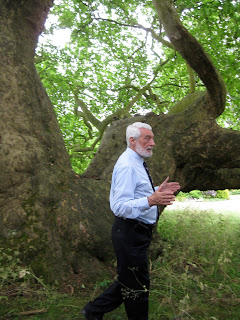July 11: Royal Geographical Society
Our visit to the Royal Geographical
Society may just be my favorite one yet.
It was so interesting! The society was founded in 1830 and was dedicated
to scientific geography, which at that time meant travel, exploration, and
cartography. They wanted to
collect accurate information to be published in the society’s journals. Some of their most famous explorations
are to find the source of the Nile, to Antarctica, and to Mt. Everest. The collection consists of 2 million
items, of which 1 million are maps.
They have 2,000 atlases; half a million images; 150,000 books; and
100,000 bound periodicals. There
is not a huge budget for digitized photos, but they try to digitize them when
someone requests something. The
RGS has 1,500 objects and artifacts which are very interesting and in high
demand for exhibitions. When they
loan out any of the objects, they are very particular of how they are packed,
shipped, and stored. Most of the
items they acquire are donations.
They are more selective now because space is a concern. They do not have a classification
scheme here. They just record the
number of the shelf that the item lives on. The staff consists of 8 team members, and they have a
volunteer group that comes in once a week to clean the books. We were told it is somewhat of a social
gathering for the group to come there every week, which I think is so cute. When necessary, they also have a
professional conservationist that they can enlist the help of. One thing I thought was really great
was that the tables had round edges so that when maps are laid on them, they
won’t crease if people lean on the table! What a great idea! It was so
fascinating to see the collection of items that were brought out for our
class. We saw the hats that Mr.
Stanley and Dr. Livingstone wore (Dr. Livingstone, I presume?). We saw some of the clothing that
Shackleton wore on his first trip to Antarctica. There was also a pocket sextant that belonged to Darwin from
1835-36. And many more really
amazing things!
British Museum Archives
When we got to the British Museum, we had to split into
two groups because the archives aren't big enough to hold our whole class at
the same time. I opted to go on the second tour, so I had some time to
wander around the museum. I have been to the British Museum a couple of
times before, but it is always interesting to see. I saw the Rosetta
Stone again, and I always like seeing the mummies. There were also some
new exhibitions that I hadn't seen before.
I was very surprised by the archive because it was not
what I expected, but it was very, very cool and the archivist is
wonderful. She is the only archivist for the museum's archives. I
think I was so surprised because I was expecting collection archives, but there
are actually 8 collecting departments and each has their own archives.
The Central Archive is where they keep museum generated administrative
records. This includes the minutes from trustee meetings dating back to
the foundation of the museum in 1753! The minutes were really interesting
to see because the trustees talked about everything. Some of them were
really funny too, because they would talk about certain patrons or other topics
and everything was recorded.
Another part of the archive holds property records.
We saw the records from when the land that the museum is currently on was
purchased. The mansion that was on the land at that time was called the
Montagu House. We saw drawers and drawers full of blueprint plans for the
building of the museum after the Montagu House was demolished. The
builders would submit plans to the trustees and the trustees would give them
feedback, so the builders would draw another plan. There were lots of
them by the end! Another thing
they keep in the Central Archives is information about their exhibitions. They have about 12,000 photographs of
exhibitions they have done in the museum since the 1960s.
Some of my favorite things we saw were the records of the
round reading room. The reading
room was very prestigious. We saw
the signatures of some of the readers, like Beatrix Potter and Karl Marx. Another of my favorites was using a
stereoscopic to look at photos and make them 3D. It was amazing.
One picture was of the Egyptian Room in 1857.



































